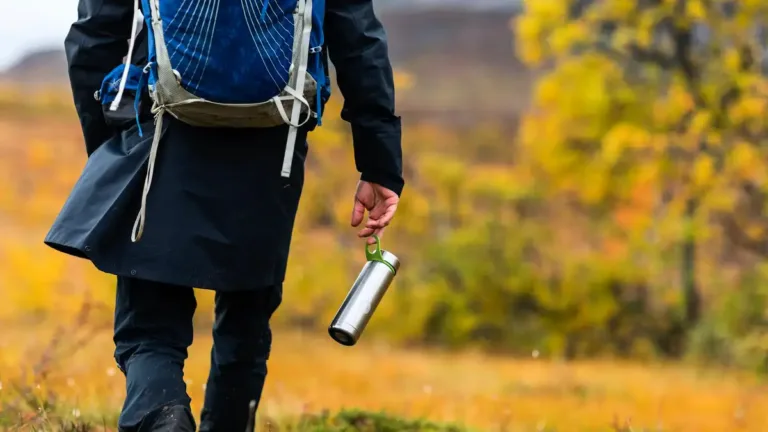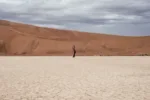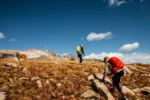How much water do I need to bring on a hike?
This post may contain affiliate links. This means that we may receive a small commission from purchases through those links. Read more in our affiliate disclosure.
Walking on a trail, stepping over roots and rocks, breathing in the fresh air, and marveling at the beauty of nature, we get lost in the experience. We often forget one of the most important aspects of hiking: How much water you bring. Now, you might say, “Water? I got it, Ray, not rocket science,” and you’d be right, it’s not. But, there’s more to hydration than meets the eye. It’s not just about quenching your thirst; it’s about keeping the machinery of your body in working order.
You see, water does a lot of things in your body. It carries nutrients to cells, removes waste, lubricates joints, and even helps regulate body temperature. When you’re hiking, you’re burning energy, and these processes are happening faster and in greater amounts. Your body loses water through sweat and breathing, which means you need to replace it by drinking more.

- Introduction
- The Rule of Thumb: Water Intake per Hour
- How much Water do I need per mile?
- How much Water do I need per Kilometer?
- What water bottle size do I need?
- What to Drink While Hiking: Water or Electrolytes?
- What Happens When I Get Dehydrated While Hiking?
- How Do I Know When to Drink Water
- Hydration Strategy Before the Hike
- Conclusion
The Rule of Thumb: Water Intake per Hour
You’ve probably heard about the 8×8 rule, which suggests drinking eight 8-ounce glasses of water a day. It’s a decent guideline for everyday living, but when you’re marching uphill with a pack on your back, it doesn’t quite cut it.
A common recommendation is to drink about half a liter of water per hour of moderate activity. For our American friends, that’s 2 cups, or 17 ounces. This is an excellent rule of thumb, but depending on the temperature and humidity, you might need to adapt it.
Say you’re hiking in the cool, gentle breezes of early spring – half a liter per hour might serve you well. But take that same hike in the height of summer, with the sun beating down and the air as thick as molasses, and you’ll find your water bottle emptying much faster. The reason is simple: heat and humidity increase your body’s water loss, so you need to drink more to compensate. In extreme heat and high-intensity activity, your hydration needs can even double, to one liter (4 cups, or 34 ounces) of water per hour.
Be extra careful when the humidity is very low or high. In low humidity, sweat sometimes dissipates before you even notice you’re sweating – make sure you drink enough water even if you don’t notice losing it.
Conversely, very high humidity can also increase your water needs: You sweat and sweat, but the humidity is too high for any significant amount of sweat to evaporate, meaning you won’t cool down, so you sweat even more. Drink at least one liter per hour, as well as enough electrolytes, in such conditions.
How much Water do I need per mile?
The average hiking speed is at least 2 miles per hour on moderate terrain. However, steep climbs can slow you down, while a gentle downhill or flat stretch can see you cover more ground faster.
Let’s start with our basic rule of thumb: approximately half a liter of water per hour of moderate activity, which we’ll take to be about 2 miles. That’s a quarter of a liter (1 cup, or 8 ounces) per mile, a handy metric.
Now, let’s make things a bit more interesting and introduce some elevation. A steep climb is a different beast altogether. You exert more effort, your heart pumps faster, and you sweat more, and you don’t cover as much distance. For every 1000 feet of elevation gain, plan on drinking around an extra half liter of water.
So, if you’re looking at a 5-mile hike with a 2000 feet elevation gain, you’d calculate your water needs like this:
5 miles (2.5 liters = 40 ounces) + 2000 feet elevation (1 liter = 16 ounces) = 3.5 liters = 56 ounces.
Here’s a handy list:
- For a 1 mile hike, you need 8 ounces of water (16 if it’s hot).
- For a 2 mile hike, you need 16 ounces of water (32 if it’s hot).
- For a 3 mile hike, you need 24 ounces of water (48 if it’s hot).
- For a 5 mile hike, you need 40 ounces of water (80 if it’s hot).
- For a 7 mile hike, you need 56 ounces of water (112 if it’s hot).
- For a 10 mile hike, you need 80 ounces of water (160 if it’s hot).
- For a 20 mile hike, you need 160 ounces of water (320 if it’s hot).
How much Water do I need per Kilometer?
The average hiker covers at least 3 kilometers per hour on moderate terrain. Uphill paths might reduce your speed, while an easy downhill or flat stretch could see you covering more ground in less time.
Let’s begin with our basic rule of thumb: approximately half a liter of water per hour of moderate activity, which, in this case, will equate to about 3 kilometers. This means you’re looking at around 167 milliliters – but let’s round – 0.2 liters of water per kilometer – a useful measure to keep in mind.
While you’re on flat ground, that is. An uphill climb is a whole different game, requiring more energy, increasing your heart rate, and accelerating perspiration. For every 500 meters of elevation gain, plan on consuming an extra half liter of water.
So, if you’re planning an 8-kilometer hike with a 500 meters elevation gain, you’d calculate your water needs like this:
8 kilometers (1.32 liters) + 500 meters elevation (0.5 liters) = 1.82 liters.
- For a 1 km hike, you need 0.2 liters of water (0.4 if it’s hot).
- For a 2 km hike, you need 0.3 liters of water (0.6 if it’s hot).
- For a 3 km hike, you need 0.5 liters of water (1 if it’s hot).
- For a 5 km hike, you need 0.8 liters of water (1.6 if it’s hot).
- For a 7 km hike, you need 1.2 liters of water (2.4 if it’s hot).
- For a 10 km hike, you need 1.6 liters of water (3.2 if it’s hot).
- For a 20 km hike, you need 3.3 liters of water (6.6 if it’s hot).
What water bottle size do I need?
Of course, when you need a lot of water, it gets heavy. I personally would never want to carry more than 2-3 litres, unless absolutely necessary. Large water bottles may seem inviting, but they get difficult to pack (or to slide back into your backpack) Also, you might want adaptability for different hike lengths. So, I would recommend owning one or multiple water bottles of about 0.5 to 1 liter size. They easily fit into the side pockets of most backpacks; and if you carry multiple of them, you can stash your backups on the bottom of your backpack, where they are easiest to carry.
Alternatively, you can use water bladders – here, I’d recommend a volume of 2-3 litres. You don’t need to fill them all the way on a shorter hike, and they won’t take up extra space even if only partially full.
When packing your bottles or filling your bladder, have a look at your map and take note of points where you can refill them: Are there restaurants you plan to stop at, rivers from which you could take (and filter!) water, drinking fountains? You only need enough water bottles to cover the longest distance between water sources.
What to Drink While Hiking: Water or Electrolytes?
So, what should you drink while hiking – plain water or something enhanced with electrolytes?
When hiking, water keeps our body running smoothly by replenishing lost fluids. However, when you sweat, you lose more than just water. You lose electrolytes—mostly sodium and potassium, but also other minerals. These microscopic workhorses help transmit nerve impulses, contract your muscles, and balance fluid levels in your body.
This is where drinks with electrolytes enter the scene. They’re like regular water but souped-up, replenishing not only your water levels but also those crucial electrolytes. This can be especially beneficial on long hikes, strenuous treks, or in hot conditions when your sweat rate—and, consequently, electrolyte loss—is high.
But before you go rushing for the sports drinks, remember that nothing in life is free. Many of these drinks can pack a sugary punch, which might provide a short-term energy boost, but could lead to a crash later on. Plus, if you’re on a long trek, too much sugar can upset your stomach.
So, which should you choose? If you’re hiking for a short duration in mild weather, good old-fashioned H2O should serve you well. But if you’re pushing your body hard, hiking in high heat, or going the distance, an electrolyte-enhanced drink might just be your ticket to staying well-hydrated and full of energy.
How to Get Electrolytes While Hiking
Electrolytes are not just in sports drinks, my friends. No, these minuscule marvels can be found in various forms, ready to accompany you on your hiking adventures.
First up, we have electrolyte tablets. Just drop one in your water bottle, give it a shake, and voila! Electrolyte-infused hydration on the go. They’re lightweight, easy to pack, and come in a variety of flavors.
Then, of course, we have the aforementioned sports drinks. They’re readily available and come in a multitude of flavors, though do watch out for those high sugar levels.
Moving on, we find ourselves looking at certain foods. Bananas, oranges, and yogurt, for example, are packed with potassium. Salted nuts or trail mix can help keep your sodium levels in check. It’s like nature’s own electrolyte delivery service.
How do you know if you need to up your electrolyte intake? Watch out for signs of electrolyte imbalance such as muscle cramps, fatigue, nausea, and, in severe cases, heart irregularities. If you’re planning a long, strenuous hike or it’s particularly hot, it might be worth including some electrolytes right from the get-go.
What Happens When I Get Dehydrated While Hiking?
Our bodies are finely tuned machines, relying on the careful balance of water and electrolytes to carry out essential functions, from cooling down through perspiration to maintaining blood volume. Water makes up 75% of your body weight when you’re a baby and about 55% when you’re older. When we start to become dehydrated—often as a result of sweating during physical exertion like hiking—we disrupt this balance.
Dehydration leads to a decrease in blood volume, as well as volume of your cells. This reduced blood volume triggers a series of responses: heart rate increases, less blood is sent to the skin, we sweat less, and our core temperature rises. Over time, this can contribute to fatigue and reduce cognitive function. In severe cases, it can lead to heat stroke, a serious and potentially fatal condition.
At the same time, dehydration reduces physical performance. Even mild dehydration—around a 2% loss in body weight—can lead to a noticeable drop in physical performance, particularly in hot environments. So, if you’re finding that the last few kilometers of your hike are tougher than they should be, you might need to up your water intake.
How Do I Know When to Drink Water
Is it enough to drink when you’re thirsty? Well, opinions somewhat differ, but it’s quite possible that by the time you feel thirsty, you might already be slightly dehydrated.
So, a good rule of thumb is to drink water regularly throughout your hike, even if you don’t feel thirsty. And if you’re sweating a lot, you might also need to replace lost salts, not just water. This is because sweat contains salts, and losing too much of them can also affect your body’s functions.
At the same time, make a point to pay attention to how thirsty you feel. Often, it’s not that we don’t get thirsty early enough; we simply don’t notice due to being distracted. If you make it a habit to check in with your body on a regular basis, you might not time your water intake so much.
Hydration Strategy Before the Hike
Starting your hike well-hydrated can provide you with a solid foundation that helps your body function optimally and prolongs the time before you feel the need to reach for your water bottle. The most effective way to ensure that you’re starting off well-hydrated is to practice what’s called ‘pre-hydration’.
This involves drinking plenty of fluids in the 24 hours leading up to your hike, and especially in the 2 hours before you set off. But don’t chug all that water in one go—it’s more effective to sip small amounts frequently, which allows your body to absorb the fluid better.
Also, keep an eye on your urine color—it can serve as a handy and intuitive gauge of your hydration status. Aim for a light, straw-like color. If it’s darker, you’re likely not hydrated enough.
Conclusion
Whether you’re venturing out for a leisurely 3-kilometer stroll or a grueling day-long trek, the principles remain the same. You need to keep your body well hydrated, balance the water and electrolyte levels, and adjust your intake based on the terrain, intensity, weather, and your body’s signals.
The beauty of this journey isn’t in blindly following the rules, but in learning to understand and listen to our bodies. We’re all wonderfully unique, each of us a marvelous microcosm that requires care and attention. Stay hydrated, keep those electrolytes balanced, and enjoy the wonderful journey of hiking.




